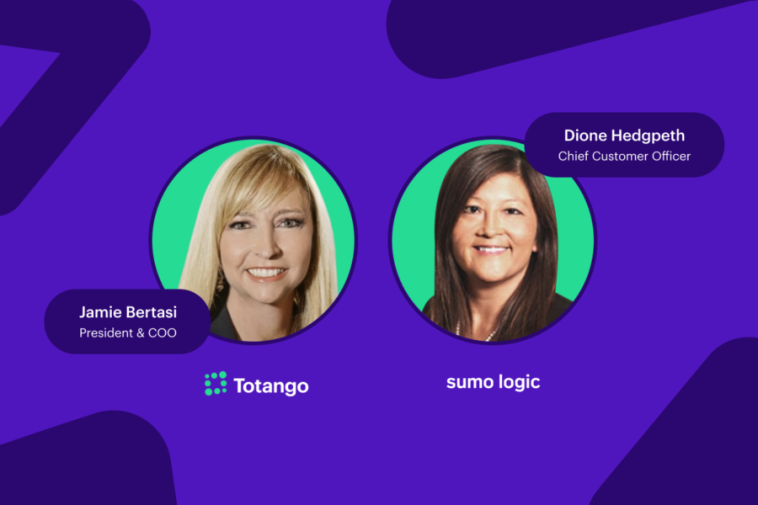- Like
- SHARE
- Digg
- Del
- Tumblr
- VKontakte
- Flattr
- Buffer
- Love This
- Save
- Odnoklassniki
- Meneame
- Blogger
- Amazon
- Yahoo Mail
- Gmail
- AOL
- Newsvine
- HackerNews
- Evernote
- MySpace
- Mail.ru
- Viadeo
- Line
- Comments
- Yummly
- SMS
- Viber
- Telegram
- JOIN
- Skype
- Facebook Messenger
- Kakao
- LiveJournal
- Yammer
- Edgar
- Fintel
- Mix
- Instapaper
- Copy Link
In order to achieve step-change growth, you need to deliver value to your customers at scale—and across their entire journey with your company. Sounds simple in concept, but where do you start?
That’s the question that Sumo Logic Chief Customer Officer Dione Hedgpeth and Totango President & COO Jamie Bertasi discussed during their session at the TSIA World: ENVISION conference. Check out six key takeaways from their discussion, plus a bonus tip from a session hosted by our friends at Higher Logic. Be sure to watch the full video below for even more helpful tips.
Start with defining the customer journey
While teams may often refer to “the customer journey,” how do you ensure alignment and shared understanding of what that means across your business? Hedgpeth shared that the first thing a customer success leader should do when joining a new company is create the journey map. Define and document how you will deliver a stand-out experience for your customers by mapping all the activities that deliver value at each stage. “If you let your customers meander around with no direction, they aren’t going to be very successful long term,” she said. More than that, the journey map doubles as a way to establish role clarity, and even as an aid in capacity planning if you take the step to understand how long each value-add activity takes, Hedgpeth added. The customer journey is the product of customer success, and like a product, the journey should be optimized based on signals from your customer success programs and other key initiatives so that you’re focused on driving customer outcomes and delivering value.
Deliver day 1 value
In our digital world, people expect instant results, so you need to deliver value to your customers early in their journey. More than that, many of us have grown accustomed to experiences continuously evolving to meet our changing needs and expectations. Hedgpeth noted that Sumo Logic does this by “shifting left,” meaning they shift their customer success assets to the left of the sales cycle rather than only utilizing them in the post-sales journey. By showing your customer journey map and customer success plan to prospects early in the sales cycle, you quickly set expectations for what you’ll provide and reassure them that you have a plan beyond just delivering the product and leaving them to fend for themselves. You can then take these assets into the post-sale process, lay them out for your customer, and prove you’re delivering the value promised and ensure they’re happy with what they’re receiving.
Deliver business outcomes, not cadence calls
While cadence calls may make sense in some situations, most people don’t have the time to sit on an unnecessary 30-minute call every month just because it’s on the calendar. Hedgpeth explained that it’s much more effective and efficient to send your customers relevant, valuable information that they can review on their own time and then reach out if they have questions or want to discuss further. This could be as simple as a quick email update or a more in-depth QBR video. Streamlining this process gives time back to customers and ensures your engagements are valuable for both parties.
Continually recalibrate and evolve
Effective customer success requires continually iterating, improving, and evolving your customer journeys and business processes. You not only need easy access to quality data, but you also need to be nimble enough to make changes and improvements to your customer journey based on the analysis of that data. Hedgpeth explained that Sumo tweaks its journey map monthly, and because they make changes so frequently, they rely on Totango’s Customer Experience Canvas tool to help visualize their journey and keep it up-to-date. Canvas allows users to design, build, run, and measure the customer journey all in one place, so it ensures accuracy and makes maintaining the journey easy and time-effective.
Signals are key to scale-up growth
Any successful company that’s onboarding many new customers needs a “tech touch,” also referred to as digital automation, to scale up. In the past, tech touch was used primarily for smaller segments, but today even the highest touch segment can benefit from a combination of digitally automated and human engagements. Hedgpeth explained that companies can drive great customer experiences by utilizing dynamic assignment and a pooled model. For instance, if a customer gets a tech touch and asks to talk to an expert, you can use dynamic assignment to send the customer to the employee who is available and has the best skills to handle that issue, guaranteeing the customer gets personalized help in a timely manner.
Grow your customer count, not your team size
In the current economic environment, customer success teams are being asked to do more with less, so you need the right resources to scale your customers without scaling your team. This means having access to quality data and utilizing tech-touch tools. Hedgpeth recommends that everyone use a digital-first approach, no matter how big or small your company is, because it will help lay the foundation for scale when the time comes. For those who are just getting started with tech touch and may not have exceptional data yet, Hedgpeth recommends beginning with time-based sequences. After you get the motion down and begin to understand your customers and what data is important, then you can move to trigger-based sequences. Tech touch gives you the insight and flexibility to make smart moves and lean into your future success.
Bonus tip: Embrace the transformative power of community
Online communities can also serve as a powerful tool to deliver value at scale along the customer journey. In their session titled “Transformative Changes Happen with Community,” Jay Nathan, EVP Corporate Market and Chief Customer Officer at Higher Logic, and Aslan Noghre-kar, VP, Customer Experience and Head of Community at Change Healthcare, discussed the impacts of communities on business. They explained how creating an online community for your customers to connect with your brand and others, share ideas, and learn and grow together can help drive business outcomes and deliver value to your customers by:
- Supporting efficient growth and ensuring customers feel supported by the company
- Enhancing product roadmaps and improving net retention
- Reducing customer burdens
- Improving customer acquisition
Noghre-kar described how building an online community where they could better connect with customers helped Change Healthcare improve its customer net retention, build sustainable growth, expand customer acquisitions, and improve the quality of their products. He explained that the key to building a successful online community is partnering with a company like Higher Logic that focuses purely on community and is willing to co-innovate with you. Check out the full video of their session to learn more about using communities to drive growth at scale and deliver more value to your customers.
Design your customer journey to deliver value at scale
As these sessions show, having the right tools and resources is key to building effective customer journeys that deliver value at scale. Totango makes it easy and simple for you to design, build, and run your customer journey, then measure your results and make adjustments, all in one place. Sign up for Totango for free and start delivering more valuable customer experiences today!





![multicultural-marketing:-what-it-is-and-how-to-do-it-the-right-way-[according-to-experts]](https://everythingflex.com/wp-content/uploads/2022/11/8928-multicultural-marketing-what-it-is-and-how-to-do-it-the-right-way-according-to-experts-150x150.jpg-23keepprotocol)